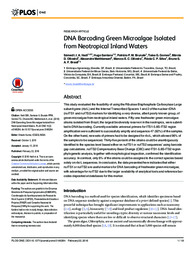DNA barcoding green microalgae isolated from neotropical inland waters.
DNA barcoding green microalgae isolated from neotropical inland waters.
Author(s): HADI, S. I. I. A; SANTANA, H.; BRUNALE, P. P. M.; GOMES, T. G.; OLIVEIRA, M. D. de; MATTHIENSEN, A.; OLIVEIRA, M. E. C.; SILVA, F. C. P.; BRASIL, B. dos S. A. F.
Summary: This study evaluated the feasibility of using the Ribulose Bisphosphate Carboxylase Large subunit gene (rbcL) and the Internal Transcribed Spacers 1 and 2 of the nuclear rDNA (nuITS1 and nuITS2) markers for identifying a very diverse, albeit poorly known group, of green microalgae from neotropical inland waters. Fifty-one freshwater green microalgae strains isolated from Brazil, the largest biodiversity reservoir in the neotropics, were submitted to DNA barcoding. Currently available universal primers for ITS1-5.8S-ITS2 region amplification were sufficient to successfully amplify and sequence 47 (92%) of the samples. On the other hand, new sets of primers had to be designed for rbcL, which allowed 96% of the samples to be sequenced. Thirty-five percent of the strains could be unambiguously identified to the species level based either on nuITS1 or nuITS2 sequences? using barcode gap calculations. nuITS2 Compensatory Base Change (CBC) and ITS1-5.8S-ITS2 region phylogenetic analysis, together with morphological inspection, confirmed the identification accuracy. In contrast, only 6% of the strains could be assigned to the correct species based solely on rbcL sequences. In conclusion, the data presented here indicates that either nuITS1 or nuITS2 are useful markers for DNA barcoding of freshwater green microalgae, with advantage for nuITS2 due to the larger availability of analytical tools and reference barcodes deposited at databases for this marker.
Publication year: 2016
Types of publication: Journal article
Unit: Embrapa Swine & Poultry
Observation
Some of Embrapa's publications are published as ePub files. To read them, use or download one of the following free software options to your computer or mobile device. Android: Google Play Books; IOS: iBooks; Windows and Linux: Calibre.
Access other publications
Access the Agricultural Research Database (BDPA) to consult Embrapa's full library collection and records.
Visit Embrapa Bookstore to purchase books and other publications sold by Embrapa.

